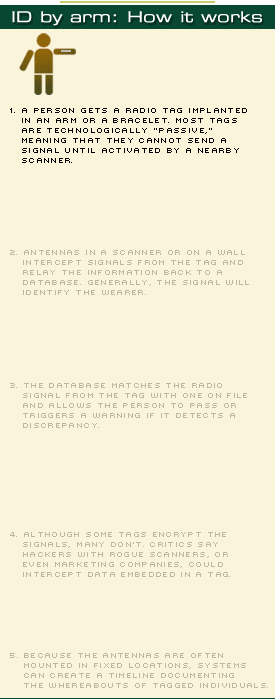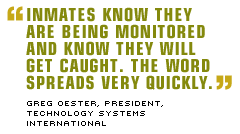
There's not a lot of middle ground on the subject of implanting electronic identification chips in humans.
Advocates of technologies like radio frequency identification tags say their potentially life-saving benefits far outweigh any Orwellian concerns about privacy. RFID tags sewn into clothing or even embedded under people's skin could curb identity theft, help identify disaster victims and improve medical care, they say.
Critics, however, say such technologies would make it easier for government agencies to track a person's every movement and allow widespread invasion of privacy. Abuse could take countless other forms, including corporations surreptitiously identifying shoppers for relentless sales pitches. Critics also speculate about a day when people's possessions will be tagged--allowing nosy subway riders with the right technology to examine the contents of nearby purses and backpacks.
"Invasion of privacy is going to be impossible to avoid," said Katherine Albrecht, the founder and director of Consumers Against Supermarket Privacy Invasion and Numbering, or CASPIAN, a watchdog group created to monitor the use of data collected in the so-called loyalty programs used increasingly by supermarkets. Albrecht worries about a day when "every physical item is registered to its owner."
The overriding idea behind tagging people with chips--whether through implants or wearable devices such as bracelets--is to improve identification and, consequently, tighten access to restricted information or physical areas.

The concept of implanting chips for tracking purposes was introduced to the general public more than a decade ago, when pet owners began using them to keep tabs on dogs and cats. The notion of embedding RFID tags in the human body, though, remained largely theoretical until the Sept. 11, 2001, terror attacks, when a technology executive saw firefighters writing their badge numbers on their arms so that they could be identified in case they became disfigured or trapped.
Richard Seelig, vice president of medical applications at security specialist Applied Digital Solutions, inserted a tracking tag in his own arm and told the company's CEO that it worked. A new product, the VeriChip, was born.
Applied Digital formed a division named after the chip and says it has sold about 7,000 of the electronic tags. An estimated 1,000 have been inserted in humans, mostly outside the United States, with no harmful physical side effects reported from the subcutaneous implants, the company said.

"It is used instead of other biometric applications," such as fingerprints, said Angela Fulcher, vice president of marketing at VeriChip, which is based in Palm Beach, Fla. The basic technology comes from Digital Angel, a sister company under the Applied corporate umbrella that has sold thousands of tags for identifying pets and other animals.
VeriChip makes 11-millimeter RFID tags that are implanted in the fatty tissue below the right tricep. When near a scanner, the chip is activated and emits an ID number. When a person's tag number matches an ID in a database, the person is allowed to enter a secured room or complete a financial transaction.
So far, enhancing physical security--controlling access to buildings or other areas--remains the most common application. RFID chips cannot track someone in real time the way the Global Positioning System does, but they can provide information such as whether a particular individual has gone through a door.
Latin American customers are looking at both technologies for security purposes, which partly explains why some of VeriChip's early clients included Mexico's attorney general, as well as a Mexican agency trying to curb the country's kidnapping epidemic, and commercial distributors in Venezuela and Colombia.
The value of these technologies was underscored recently by a CNET News.com reader who wrote from Puerto Rico to inquire about their development. In her e-mail, Frances Pabon said she hopes that RFID or GPS technologies can be used for her husband, who must travel through neighborhoods in San Juan that are infested with crack dealers.
"I think safeguarding his safety doesn't necessarily violate his privacy," she wrote. "And if I am made to choose between keeping him safe versus keeping him private, I'd rather keep him safe and then change private data such as credit cards, bank accounts, etc., after."
Safety has been a primary driver in some U.S. applications as well. An Arizona company called Technology Systems International, for example, says it has improved security in prisons with an RFID-like system for inmates and guards. The company's products came out in 2001 and are based on technology licensed from Motorola, which created it for the U.S. military to find gear lost in battle.

TSI's wristbands for inmates transmit signals every two seconds to a battery of antennas mounted in the prison facility. By examining the time the signal is received by each antenna, a computer can determine the exact location of each prisoner at any given time and can reconstruct prisoners' movements later, if necessary to investigate their actions.
Since the technology was installed at participating prisons, violence is down up to 60 percent in some facilities, said TSI President Greg Oester, who says the wristbands are designed for the "uncooperative user." TSI, a division of security company Alanco Technologies, has installed the system in four prisons and will add a fifth soon.
"Inmates know they are being monitored and know they will get caught. The word spreads very quickly," Oester said. "It increases the safety in facilities."
In a California prison that uses the TSI technology, an inmate confessed to stabbing another prisoner 20 minutes after authorities showed him data from his radio transmitter that placed him in the victim's cell at the time of the stabbing, Oester said. A women's prison in the state has begun a pilot program to test whether the technology prevents sexual assaults.
Conversely, at an Illinois prison, Oester said, convicts have pointed to this sort of data as a way to prove that they weren't involved in prison incidents. Guards have similar tags, embedded in pagers rather than wristbands, which set off an alarm if they are removed or tampered with.
Tagging hospital patients...and alumni?Hospitals in Europe and the United States are also experimenting with inserting tags in ID bracelets. The Jacobi Medical Center in New York, along with Siemens Business Services, has launched a pilot program that will outfit more than 200 patients with radio bracelets.
This technology is designed to enable various health care professionals to obtain patient information such as X-rays and medical histories from a database securely and more quickly. The system will also use antennas to track individuals as they walk about the hospital and send alerts if a patient begins to collapse. Other pilot systems are being tested specifically to monitor patients with Alzheimer's disease.
As such tagging systems become more widely known, some industries that hadn't been expected to use the technology are considering innovative applications of it. A South Carolina firearms maker, FN Manufacturing, is evaluating the technology for use in "smart guns" equipped with grip sensors that would allow only their owners to use them.
In a less violent but practical application, Ray Hogan of Princeton University's alumni association has contemplated distributing RFID bracelets among meeting attendees to track attendance at events that have multiple components. The technology would let organizers see which programs attendees find most valuable by virtue of how long they stay. Like others, however, Hogan says privacy issues may well keep the idea from becoming a reality.
When such technologies are employed, they can be even more effective if implanted in the body. Supporters and critics both say RFID tags under the skin would invariably increase the volume and quality of personal data, with the benefit of, at the very least, reducing the margin of error for misidentification in the event of a disaster.

The problem, detractors say, is that the vast quantities of accumulated data would be vulnerable to theft and abuse. They cite historical practices of retail establishments, which for years have listened in on customer conversations and viewed consumer behavior on remote cameras to improve sales. Supermarkets routinely collect data about individual shoppers' purchases and buying habits through "loyalty programs," along with credit card and electronic banking transactions.
Even random individuals could spy on those with tags, because today's RFID technologies do not yet have the processing power to encrypt information. "I don't see how you can get enough power into those things" to encrypt data, said Whitfield Diffie, a fellow and security expert at Sun Microsystems.
Some consumers have described scenarios in which a hacker could extract a person's identification number with an RFID reader, create a chip with the same number and then impersonate them. But even if such chip forgery were possible, alerts would probably be sounded as soon as a system detected that the same person was in two different places at once.
Still, implanting RFID chips could vastly increase the potential for police surveillance of ordinary citizens. Conceivably, every wall socket could become an RFID reader that feeds into a government database.
Critics contend that if tagging gets out of control, the day will eventually come when the cops will be able to trace junk thrown in a public trash can back to the person who tossed it.
"Do you want the people in power to have that much power?" Albrecht asked rhetorically. "The infrastructure obstacle has been overcome. It is called electricity and the Internet."
Related News
Under-the-skin ID chips move toward U.S. hospitals
Portuguese pooches to get radio-tagged
After years of struggle, GPS is taking off
RFID tags become hacker target
More news around the Web
Wireless World: RFID to thwart terrorism
United Press International
RFID: Getting under your skin?
Fortune
Wave your RFID card to get a burger
The Inquirer
RFID hack could allow retail fraud
eWeek
Japanese bank taps RFID for document security
InfoWorld
Editors: Mike Yamamoto, Yvonne Guzman
Copy editor: Zoë Barton
Design: Ellen Ng
Production: Mike Markovich